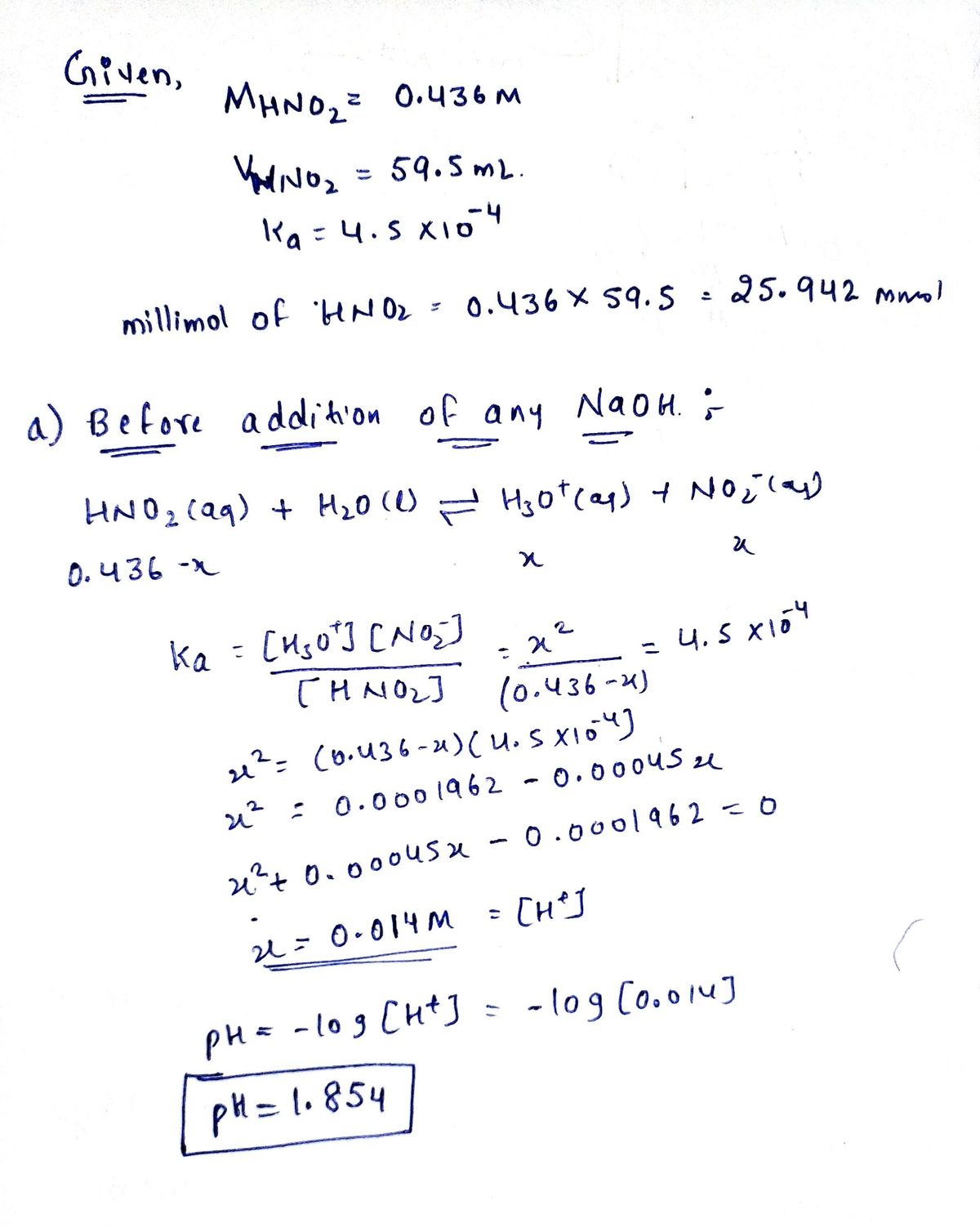Calculate pH for a weak acid/strong base titration. Determine the pH during the titration of 59.5 mL of 0.436 M nitrous acid (K₂ = 4.5x10-4) by 0.436 M NaOH at the following poin (a) Before the addition of any NaOH (b) After the addition of 15.0 mL of NaOH (c) At the half-equivalence point (the titration midpoint) (d) At the equivalence point (e) After the addition of 89.3 mL of NaOH
Calculate pH for a weak acid/strong base titration. Determine the pH during the titration of 59.5 mL of 0.436 M nitrous acid (K₂ = 4.5x10-4) by 0.436 M NaOH at the following poin (a) Before the addition of any NaOH (b) After the addition of 15.0 mL of NaOH (c) At the half-equivalence point (the titration midpoint) (d) At the equivalence point (e) After the addition of 89.3 mL of NaOH
Chemistry
10th Edition
ISBN:9781305957404
Author:Steven S. Zumdahl, Susan A. Zumdahl, Donald J. DeCoste
Publisher:Steven S. Zumdahl, Susan A. Zumdahl, Donald J. DeCoste
Chapter1: Chemical Foundations
Section: Chapter Questions
Problem 1RQ: Define and explain the differences between the following terms. a. law and theory b. theory and...
Related questions
Question

Transcribed Image Text:**Title: Calculating pH for a Weak Acid/Strong Base Titration**
**Objective:**
Determine the pH during the titration of nitrous acid by sodium hydroxide at various points.
**Experiment Details:**
- **Initial Solution:**
- Volume: 59.5 mL
- Concentration: 0.436 M nitrous acid
- Acid dissociation constant, \( K_a = 4.5 \times 10^{-4} \)
- **Titrant:**
- Concentration: 0.436 M NaOH
**Titration Points:**
(a) **Before the addition of any NaOH:**
Calculate the initial pH of the nitrous acid solution.
(b) **After the addition of 15.0 mL of NaOH:**
Determine the pH after adding a specified volume of the base.
(c) **At the half-equivalence point (the titration midpoint):**
Calculate the pH when half of the acid is neutralized.
(d) **At the equivalence point:**
Determine the pH when the amount of base added completely neutralizes the acid.
(e) **After the addition of 89.3 mL of NaOH:**
Find the pH after adding more base than needed to reach the equivalence point.
Expert Solution
Step 1

Step by step
Solved in 4 steps with 4 images

Knowledge Booster
Learn more about
Need a deep-dive on the concept behind this application? Look no further. Learn more about this topic, chemistry and related others by exploring similar questions and additional content below.Recommended textbooks for you

Chemistry
Chemistry
ISBN:
9781305957404
Author:
Steven S. Zumdahl, Susan A. Zumdahl, Donald J. DeCoste
Publisher:
Cengage Learning

Chemistry
Chemistry
ISBN:
9781259911156
Author:
Raymond Chang Dr., Jason Overby Professor
Publisher:
McGraw-Hill Education

Principles of Instrumental Analysis
Chemistry
ISBN:
9781305577213
Author:
Douglas A. Skoog, F. James Holler, Stanley R. Crouch
Publisher:
Cengage Learning

Chemistry
Chemistry
ISBN:
9781305957404
Author:
Steven S. Zumdahl, Susan A. Zumdahl, Donald J. DeCoste
Publisher:
Cengage Learning

Chemistry
Chemistry
ISBN:
9781259911156
Author:
Raymond Chang Dr., Jason Overby Professor
Publisher:
McGraw-Hill Education

Principles of Instrumental Analysis
Chemistry
ISBN:
9781305577213
Author:
Douglas A. Skoog, F. James Holler, Stanley R. Crouch
Publisher:
Cengage Learning

Organic Chemistry
Chemistry
ISBN:
9780078021558
Author:
Janice Gorzynski Smith Dr.
Publisher:
McGraw-Hill Education

Chemistry: Principles and Reactions
Chemistry
ISBN:
9781305079373
Author:
William L. Masterton, Cecile N. Hurley
Publisher:
Cengage Learning

Elementary Principles of Chemical Processes, Bind…
Chemistry
ISBN:
9781118431221
Author:
Richard M. Felder, Ronald W. Rousseau, Lisa G. Bullard
Publisher:
WILEY